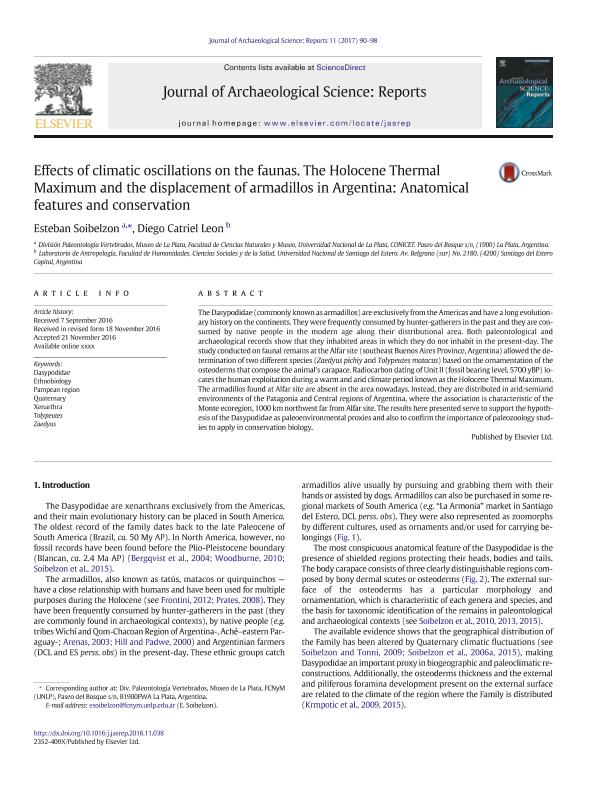Mostrar el registro sencillo del ítem
dc.contributor.author
Soibelzon, Esteban

dc.contributor.author
Leon, Diego Catriel

dc.date.available
2017-07-13T19:02:34Z
dc.date.issued
2017-02
dc.identifier.citation
Soibelzon, Esteban; Leon, Diego Catriel; Effects of climatic oscillations on the faunas. The Holocene Thermal Maximum and the displacement of armadillos in Argentina: Anatomical features and conservation; Elsevier; Journal of Archaeological Science: Reports ; 11; 2-2017; 90-98
dc.identifier.uri
http://hdl.handle.net/11336/20377
dc.description.abstract
The Dasypodidae (commonly known as armadillos) are exclusively from the Americas and have a long evolutionary history on the continents. They were frequently consumed by hunter-gatherers in the past and they are consumed by native people in the modern age along their distributional area. Both paleontological and archaeological records show that they inhabited areas in which they do not inhabit in the present-day. The study conducted on faunal remains at the Alfar site (southeast Buenos Aires Province, Argentina) allowed the determination of two different species (Zaedyus pichiy and Tolypeutes matacus) based on the ornamentation of the osteoderms that compose the animal´s carapace. Radiocarbon dating of Unit II (fossil bearing level, 5700 yBP) locates the human exploitation during a warm and arid climate period known as the Holocene Thermal Maximum. The armadillos found at Alfar site are absent in the area nowadays. Instead, they are distributed in arid/semiarid environments of the Patagonia and Central regions of Argentina, where the association is characteristic of the Monte ecoregion, 1000 km northwest far from Alfar site. The results here presented serve to support the hypothesis of the Dasypodidae as paleoenvironmental proxies and also to confirm the importance of paleozoology studies to apply in conservation biology.
dc.format
application/pdf
dc.language.iso
eng
dc.publisher
Elsevier

dc.rights
info:eu-repo/semantics/openAccess
dc.rights.uri
https://creativecommons.org/licenses/by-nc-sa/2.5/ar/
dc.subject
Dasypodidae
dc.subject
Ethnobiology
dc.subject
Pampean Region
dc.subject
Quaternary
dc.subject
Tolypeutes
dc.subject
Xenarthra
dc.subject
Zaedyus
dc.subject.classification
Paleontología

dc.subject.classification
Ciencias de la Tierra y relacionadas con el Medio Ambiente

dc.subject.classification
CIENCIAS NATURALES Y EXACTAS

dc.title
Effects of climatic oscillations on the faunas. The Holocene Thermal Maximum and the displacement of armadillos in Argentina: Anatomical features and conservation
dc.type
info:eu-repo/semantics/article
dc.type
info:ar-repo/semantics/artículo
dc.type
info:eu-repo/semantics/publishedVersion
dc.date.updated
2017-07-13T18:17:25Z
dc.identifier.eissn
2352-409X
dc.journal.volume
11
dc.journal.pagination
90-98
dc.journal.pais
Estados Unidos

dc.description.fil
Fil: Soibelzon, Esteban. Universidad Nacional de La Plata. Facultad de Ciencias Naturales y Museo. Departamento Científico de Paleontología de Vertebrados; Argentina. Consejo Nacional de Investigaciones Científicas y Técnicas; Argentina
dc.description.fil
Fil: Leon, Diego Catriel. Universidad Nacional de Santiago del Estero. Facultad de Humanidades Cs.sociales y de la Salud; Argentina
dc.journal.title
Journal of Archaeological Science: Reports
dc.relation.alternativeid
info:eu-repo/semantics/altIdentifier/doi/http://dx.doi.org/10.1016/j.jasrep.2016.11.038
dc.relation.alternativeid
info:eu-repo/semantics/altIdentifier/url/http://www.sciencedirect.com/science/article/pii/S2352409X16305545
Archivos asociados
